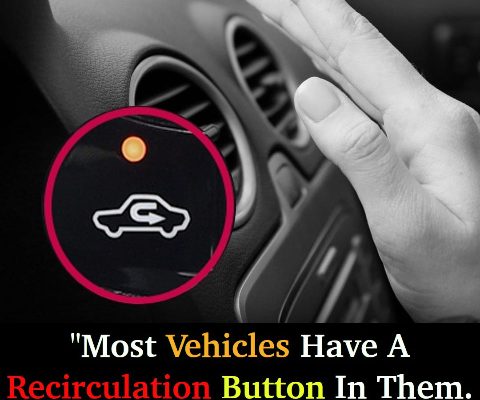Modern cars come with a variety of buttons and controls designed to improve your comfort, efficiency, and safety. One feature that often gets overlooked is the air recirculation button. Although it might not seem as essential as your AC or heating controls, knowing how and when to use this button can significantly enhance your driving experience by improving air quality and temperature control inside your vehicle.

What Is the Air Recirculation Button and How Does It Work?
The air recirculation button is typically represented by a symbol of a car with a circular arrow. Its primary function is to recirculate the air already inside the cabin rather than pulling in outside air. When activated, it keeps the air within the car, preventing hot, cold, or polluted air from entering.
This function is particularly helpful when you want to cool the interior quickly on a hot day. By reusing the cooler air already inside the vehicle, your air conditioning system doesn’t need to work as hard to lower the temperature. The result? Faster cooling, better air quality, and increased efficiency.
The Benefits of Using the Air Recirculation Button
The air recirculation button offers multiple benefits beyond just helping you stay cool in the summer. Here’s how it can improve your driving experience:
1. Enhanced Fuel Efficiency
One of the major benefits of using the air recirculation button is that it can improve your vehicle’s fuel efficiency. When recirculating the already-cooled air inside the car, your AC system doesn’t have to work as hard to cool down fresh, hot air from outside. This reduces the strain on your AC and, in turn, helps your engine use less fuel. Over time, particularly on long drives in warm weather, this can lead to noticeable fuel savings.
2. Cleaner Air Inside the Cabin
When driving through urban areas, heavy traffic, or industrial zones, the outside air can be full of exhaust fumes, dust, and pollutants. By using the air recirculation feature, you can block this dirty air from entering your car and instead keep circulating cleaner air that’s already inside the vehicle. This is especially beneficial for passengers with respiratory issues, allergies, or sensitivities to outdoor pollutants.
In fact, experts recommend using the recirculation mode when driving in areas with high pollution or during times when the air quality is poor. This simple step can significantly improve the air inside your car, making it healthier and more comfortable for everyone.
3. Faster and More Efficient Cooling
On extremely hot days, the air recirculation button helps your car cool down faster by reusing the air that has already been cooled. Instead of working to cool the hot air outside, your AC circulates the already-conditioned air inside, helping it reach the desired temperature more quickly. This reduces the strain on your AC system and allows it to operate more efficiently, especially when the outdoor temperature is scorching.
When and Where to Use the Air Recirculation Button
While the air recirculation button has several benefits, using it in the right scenarios can make a big difference in your comfort and vehicle’s performance. Here are some situations where the air recirculation feature works best:
1. In Hot Weather
The air recirculation button is most useful during the summer or in hot climates. Since it helps your air conditioning system cool down the interior more quickly by keeping out the hot air, you’ll experience faster relief from the heat. Instead of cooling the hot outdoor air, the AC works more efficiently with air that’s already cooler.
2. In Polluted Areas
If you’re driving through a city with poor air quality or an industrial zone filled with pollutants, using the recirculation feature can help prevent dust, fumes, and other contaminants from entering your vehicle. This is especially important if you or your passengers have respiratory issues. By keeping the outside air out, the recirculation mode helps you avoid breathing in harmful substances.
3. To Block Unpleasant Odors
Sometimes you might find yourself driving through areas with strong odors, like farms, landfills, or even construction zones. In these situations, activating the air recirculation button can help block those odors from entering your car. It traps the fresher air inside, ensuring you can enjoy your drive without being overwhelmed by unpleasant smells.
When Not to Use the Air Recirculation Button
While the air recirculation mode is incredibly useful, there are certain times when it’s better to avoid using it. Here’s when you should consider turning it off:
1. In Cold or Humid Weather
Using the air recirculation button in cold or humid weather can cause the windows to fog up due to moisture buildup inside the cabin. Since recirculating the same air increases humidity, this can lead to visibility issues. In these cases, it’s better to switch to fresh air mode to allow outside air to help defog the windows and maintain clear visibility.
2. On Long Drives
Keeping the recirculation mode on for too long during long road trips can cause the air in the car to become stale due to rising carbon dioxide levels. To keep the air inside the vehicle fresh, it’s a good idea to switch to fresh air mode periodically, allowing new, oxygen-rich air to flow into the cabin.
3. For Passengers with Respiratory Concerns
While the recirculation mode helps block outdoor pollutants, it may not always be ideal for people with specific respiratory concerns. If indoor air quality is a concern, switching to fresh air mode allows filtered outdoor air to enter, providing cleaner, more refreshing air inside the vehicle.
Conclusion: Make the Most of the Air Recirculation Button
The air recirculation button might be small, but it’s a powerful tool in your car’s climate control system. From cooling down your vehicle faster to improving air quality and blocking out unpleasant odors, this button can make your ride more comfortable and efficient.
By understanding when and how to use the air recirculation mode, you can take full control of your vehicle’s air quality and improve your overall driving experience. So next time you get behind the wheel, don’t underestimate the power of this feature—it could be the key to a cooler, cleaner, and more pleasant ride!



